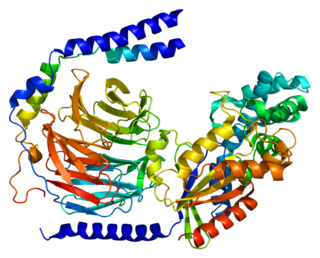Nucleoside diphosphate kinase B is an enzyme that in humans is encoded by the NME2 gene. [5] [6]
Nucleoside diphosphate kinase B is an enzyme that in humans is encoded by the NME2 gene. [5] [6]
Nucleoside diphosphate kinase (NDK) exists as a hexamer composed of 'A' (encoded by NME1) and 'B' (encoded by this gene) isoforms. Multiple alternatively spliced transcript variants encoding the same isoform have been found for this gene. Co-transcription of this gene and the neighboring upstream gene (NME1) generates naturally occurring transcripts (NME1-NME2) which encode a fusion protein consisting of sequence sharing identity with each individual gene product. [6]
NME2 has been shown to interact with NME3 [7] [8] and HERC5. [9]

Nucleoside-diphosphate kinases are enzymes that catalyze the exchange of terminal phosphate between different nucleoside diphosphates (NDP) and triphosphates (NTP) in a reversible manner to produce nucleotide triphosphates. Many NDP serve as acceptor while NTP are donors of phosphate group. The general reaction via ping-pong mechanism is as follows: XDP + YTP ←→ XTP + YDP. NDPK activities maintain an equilibrium between the concentrations of different nucleoside triphosphates such as, for example, when guanosine triphosphate (GTP) produced in the citric acid (Krebs) cycle is converted to adenosine triphosphate (ATP). Other activities include cell proliferation, differentiation and development, signal transduction, G protein-coupled receptor, endocytosis, and gene expression.

RAR-related orphan receptor beta (ROR-beta), also known as NR1F2 is a nuclear receptor that in humans is encoded by the RORB gene.

RAR-related orphan receptor alpha (RORα), also known as NR1F1 is a nuclear receptor that in humans is encoded by the RORA gene. RORα participates in the transcriptional regulation of some genes involved in circadian rhythm. In mice, RORα is essential for development of cerebellum through direct regulation of genes expressed in Purkinje cells. It also plays an essential role in the development of type 2 innate lymphoid cells (ILC2) and mutant animals are ILC2 deficient. In addition, although present in normal numbers, the ILC3 and Th17 cells from RORα deficient mice are defective for cytokine production.

Myc box-dependent-interacting protein 1, also known as Bridging Integrator-1 and Amphiphysin-2 is a protein that in humans is encoded by the BIN1 gene.

Nucleoside diphosphate kinase A is an enzyme that in humans is encoded by the NME1 gene. It is thought to be a metastasis suppressor.

T-cell lymphoma invasion and metastasis-inducing protein 1 is a protein that in humans is encoded by the TIAM1 gene.

RAC-gamma serine/threonine-protein kinase is an enzyme that in humans is encoded by the AKT3 gene.

Telomeric repeat-binding factor 1 is a protein that in humans is encoded by the TERF1 gene.

Protein NDRG1 is a protein that in humans is encoded by the NDRG1 gene.

Guanine nucleotide-binding protein G(I)/G(S)/G(O) subunit gamma-2 is a protein that in humans is encoded by the GNG2 gene.

Oxidoreductase HTATIP2 is an enzyme that in humans is encoded by the HTATIP2 gene. It may be a metastasis suppressor.

Matrix metalloproteinase-16 is an enzyme that in humans is encoded by the MMP16 gene.

Myc-associated zinc finger protein is a protein that in humans is encoded by the MAZ gene.

Integrin beta-1-binding protein 1 is a protein that in humans is encoded by the ITGB1BP1 gene.

Ras Related Glycolysis Inhibitor and Calcium Channel Regulator (RRAD) is a protein that in humans is encoded by the RRAD gene. RRAD is a Ras-related small GTPase that is regulated by p53 and plays a role in the regulation of aerobic glycolysis.

Connector enhancer of kinase suppressor of ras 1 is an enzyme that in humans is encoded by the CNKSR1 gene.

Histidine triad nucleotide-binding protein 1 also known as adenosine 5'-monophosphoramidase is an enzyme that in humans is encoded by the HINT1 gene.

Nucleoside diphosphate kinase 3 is an enzyme that in humans is encoded by the NME3 gene.

Non-metastatic cells 4, protein expressed in, also known as NME4, is a protein which in humans is encoded by the NME4 gene.

Thioredoxin domain-containing protein 3 (TXNDC3), also known as spermatid-specific thioredoxin-2 (Sptrx-2), is a protein that in humans is encoded by the NME8 gene on chromosome 7.